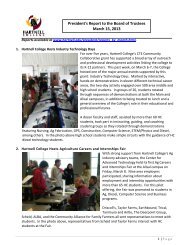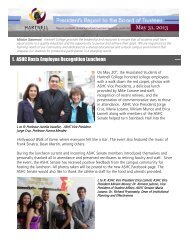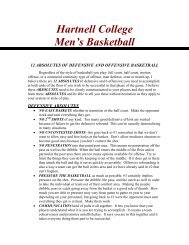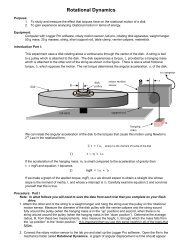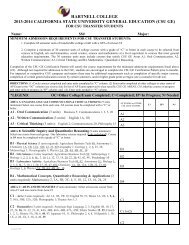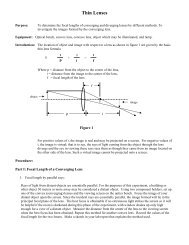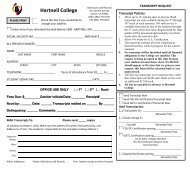Accreditation - Hartnell College!!
Accreditation - Hartnell College!!
Accreditation - Hartnell College!!
Create successful ePaper yourself
Turn your PDF publications into a flip-book with our unique Google optimized e-Paper software.
Institutional Self Evaluation – 12-05-12<br />
parties could not agree on the issue of whether academic chairs could perform faculty<br />
evaluations. With no deans, and faculty chairs not performing evaluations, the evaluations of<br />
part-time faculty became backlogged. Academic chairs was declared a dead issue.<br />
The Academic Affairs Office was reorganized again in fall 2011, bringing back several dean<br />
positions. This, too, met with difficulty, as the college now faced a fine for coming short of<br />
its 50% obligation. Although it successfully obtained an exemption, at the end of that school<br />
year, in response to budgetary issues and concerns about both the 50% law and its faculty<br />
obligation number (since two of the new dean positions were quite ably being filled by<br />
faculty in interim roles), the college eliminated three of the new dean positions it had just<br />
created.<br />
These changes and the diminishing resources to apply to non-faculty positions have made<br />
regular evaluations of part-time faculty a challenge.<br />
EVALUATION OF CLASSIFIED STAFF<br />
All classified staff (CSEA, L-39, and confidential staff) are evaluated periodically by their<br />
supervisors, according to written criteria that includes the assessment of performance of<br />
assigned duties, the quality and quantity of work, working relationship and attitudes,<br />
organizational and team relationships, work habits, and attendance. Employees are evaluated<br />
on the basis of the specific job duties listed in an employee‘s job descriptions, and the<br />
evaluations must be based on the personal knowledge and observation of the supervisor.<br />
(except that the CSEA evaluation allows a supervisor to use the knowledge of appropriate<br />
third parties if substantiated by the supervisor).<br />
Probationary employees are evaluated at least twice before the end of their probationary<br />
period. For CSEA, this period is nine months, for confidential and L-39, the period is 12<br />
months. Thereafter, employees are evaluated at least once every two years.<br />
The evaluation procedures for the CSEA (article 7 of the CBA) and L-39 (article 31) are<br />
substantially similar. The classified staff evaluation procedures require that the supervisor<br />
and employee meet to discuss the evaluation and for the supervisor to give specific<br />
recommendation and direction to the employee. If a plan of improvement or assistance is<br />
warranted, the supervisor and employee develop the plan together.<br />
Both the employee and supervisor sign the evaluation, and employees are given a copy of the<br />
evaluation at the evaluation meeting. A copy is placed in the employee‘s personnel file. A<br />
process exists for employees to appeal all or part of an evaluation to the next level manager.<br />
The evaluation results in ratings on each of the seven criteria that range from<br />
―Unsatisfactory/performance deficient‖ to ―exceeds expected standards.‖ Two classified<br />
groups have are rated on a five-point scale. Through the bargaining process, the CSEA‘s tool<br />
was recently changed to a three-point scale. For probationary employees, the evaluation will<br />
include a recommendation regarding continued employment.<br />
Page 196




